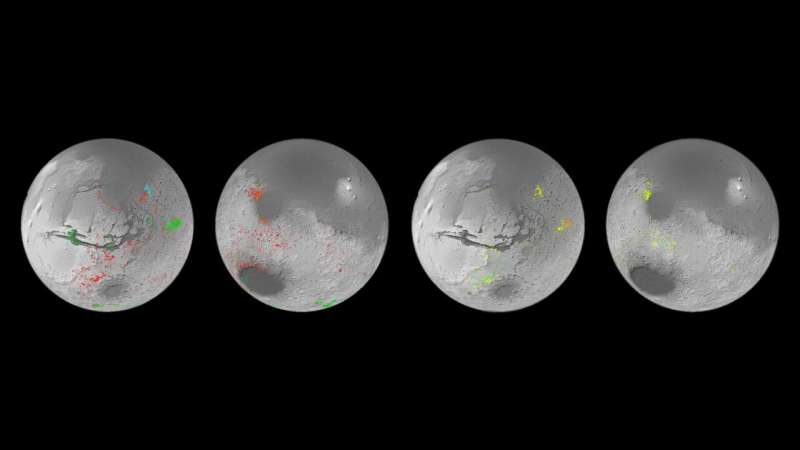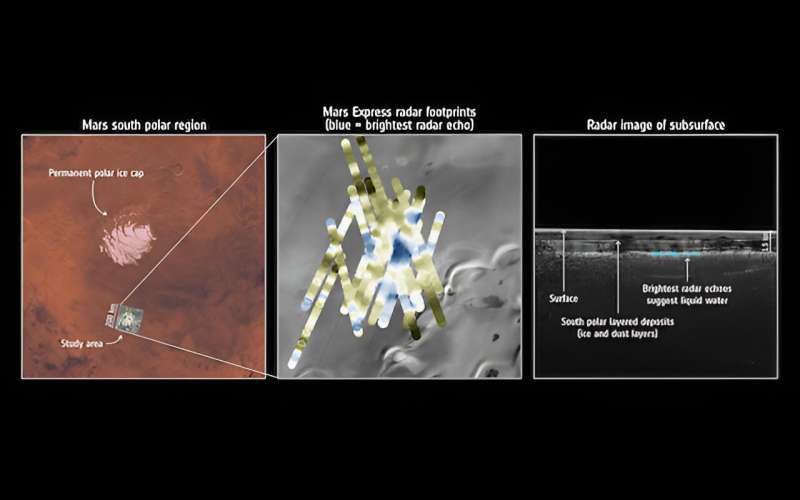
Mineral map of Mars showing the presence of the patch formed in the presence of water. Credit: ESA
In the coming decades, several space agencies and private companies plan to establish outer bases on the moon and Mars. These outposts will allow extended stays, stellar biological research, and facilitate future exploration of the solar system. But having teams working remotely from the ground for extended periods also presents some serious logistical challenges.
Given the distance and associated costs, sending resupply missions would be both impractical and expensive. For this reason, reliance on local resources to meet mission requirements—known as. On-Site Resource Utilization (ISRU)—is the name of the game.
The need for ISRU is particularly important on Mars because resupply missions can take six to nine months to get there. Fortunately, Mars has abundant resources that can be harvested and used to provide everything from oxygen, propellant, water, soil to grow food and building materials.
In a recent study, a team led by the Freie Universität Berlin evaluated the potential for resource harvesting from several previously identified hydrated mineral deposits on the surface of Mars. They also provided estimates of how much water and minerals could be recovered and how they could be used.
The team was led by Christoph Gross, a postdoctoral researcher in the Planetary Sciences and Remote Sensing Group at the Institute of Geological Sciences at the Freie Universität Berlin. They were joined by researchers from the SETI Institute, NASA’s Amis Research Center, the Institute for Spatial Astrophysics, and the Institute for Space Systems at the German Space Center (DLR).
Their paper, “In-situ Sourcing for Future Crew Missions to Mars,” was published in. Acta Astronautica magazine.
As the authors note, NASA and other space agencies have invested in ISRU technologies to reduce the overall mass that must be sent to the moon or Mars to support human exploration efforts.
In recent years, this has led to experiments such as the Mars Oxygen Source In Situ Experiment (MOXIE) on NASA’s Perseverance rover, which produced oxygen gas from the carbon dioxide of the Martian atmosphere. ESA is also preparing an ISRU demonstration mission to demonstrate that water and oxygen can be produced from water ice collected on the moon.
These resources will have uses for life support systems, ensuring mission crews have breathable air and water for drinking and irrigation. However, they also have applications for power and propulsion, supplying hydrogen gas to fuel cells or reactors and are used in combination to create liquid hydrogen (LH2) and liquid oxygen (LOX) propulsion. On Mars, most of the water there today is concentrated in polar glaciers and permafrost or in pockets of hydrated minerals where water once flowed on the surface.
For the sake of their study, Gross and his colleagues focused on hydrated mineral sites since they offer the potential to extract water directly from the water surface and at low latitudes. But as Gross told Universe Today via email, these deposits also have potential resource uses that go beyond just water:

The discovery of water under the South Pole of Mars. Credits: Context Map: NASA/Viking; THEMIS BACKGROUND: NASA/JPL-Caltech/Arizona State University; MARSIS data: ESA/NASA/JPL/ASI/Univ. Rome; R. Orosei et al
“The hydrated minerals on Mars are the largest water reservoir on Mars ever known (mainly sulfates and phyllosilicates). Water can be extracted from sulfates relatively easily and as the paper mentions, the minerals can be used as feedstock for food production can.” Phyllosilicates be used as building materials or for ceramics for example Water is the most important resource, especially the production of propellants This may be more attractive for Mars due to its distance from Earth, gravity and so on.
Next, Gross and his colleagues evaluated the various geographical locations where hydrated minerals were detected based on data obtained by the Compact Reconnaissance Imaging Spectrometer for Mars (CRISM) on NASA’s Mars Reconnaissance Orbiter (MRO).
This included Maurs Vallis, an ancient flood channel opening into the plains of Cris Planitia in the northern hemisphere of Mars, and Juventa Chasma, a 5 km (~3 mi) deep basin located north of Valles Marineris.
“Areas that host a variety of different materials may be interesting,” Gross said.
“Then, the location should be easily accessible (not in a canyon, etc.), and it should be close to scientific attractions. I also support the idea of having a base in equatorial regions where temperatures are not too cold.” And there should be enough space around the base to grow with follow-up missions.
Gross and colleagues also suggested how these resources should be extracted. According to the authors, the dehydration of mono sulfates and polyhydrates is theoretically the best method, since there are several methods that use relatively straightforward, rapid, and energy-efficient ways to do this.
They also recommend that navigators be sent robotic missions in advance to explore, assess, and begin harvesting and processing these resources in anticipation of their arrival.
“Robotic precursor missions can start mining and refining resources, especially for propellant production,” Gross said. “NASA and private companies are doing a lot of research on this point. Also, for example, building robotic habitats or pre-producing oxygen are thought provoking projects.”
This analysis presents new possibilities for long-term exploration and habitation on Mars. Although the polar regions are seen as ideal places to build future habitats, mainly because of the abundant frozen water they have access to, mining this ice (especially from deep underground sources) will be expensive and limited.
The possibility of using hydrated minerals not only offers an alternative to ISRU operations on Mars, but also opens up sites in the equator for exploration and habitat construction.
More information:
Christoph Gross et al., In-situ sourcing for future crewed missions to Mars, Acta Astronautica (2024). doi: 10.1016/j.actaastro.2024.07.003
Provided by Universe Today
translate: Can resources on Mars support human exploration? (2024, July 15) Retrieved July 16, 2024, from https://phys.org/news/2024-07-resources-mars-human-explorers.html
This document is subject to copyright. Except for any fair dealing for the purpose of research or private investigation, no part may be reproduced without written permission. The content is provided for informational purposes only.
#resources #Mars #support #human #exploration